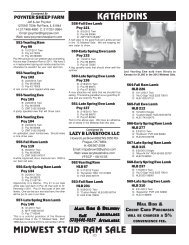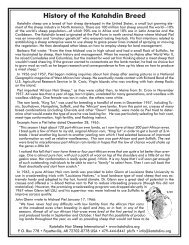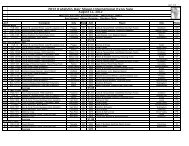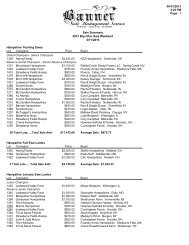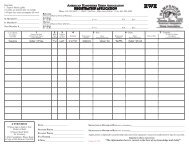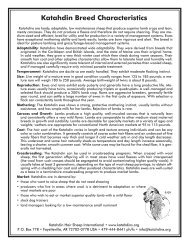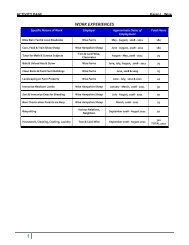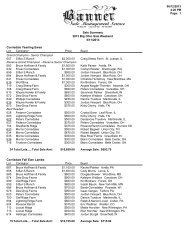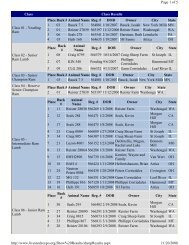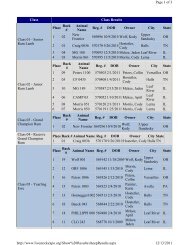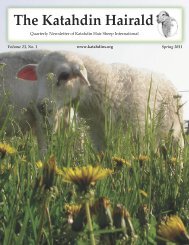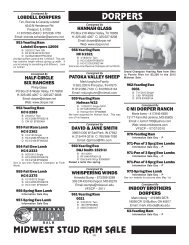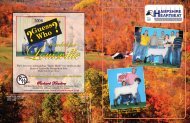KHSI Hairald Summer 2007
KHSI Hairald Summer 2007
KHSI Hairald Summer 2007
You also want an ePaper? Increase the reach of your titles
YUMPU automatically turns print PDFs into web optimized ePapers that Google loves.
How Close Can We Get to a Flock with the Birth Type We Prefer?<br />
By James Morgan, Arkansas Katahdin<br />
Breeder<br />
Often, I receive calls to our<br />
sheep breed association office<br />
about shepherds wanting<br />
all twins or more triplets or less<br />
singles. Can we achieve a flock that<br />
only has twins or only triples? Before<br />
going on, I think it is worth repeating<br />
a few of the comments often made<br />
by many shepherds. The most frequent<br />
comment is that “I want my<br />
yearlings to single and my 2 yr and<br />
older ewes to twin. I can do without<br />
triplets”. A few shepherds favor all<br />
triplets and a few would live with a<br />
few singles if that meant no triplet<br />
births.<br />
So what is possible? Can we select<br />
for a flock that has only twins<br />
(> 90%) or a flock with only triplets?<br />
If not, what percentage do we have<br />
to live with? Can the scientists who<br />
study reproduction in sheep help us<br />
understand what is possible? Yes,<br />
they can tell us what to expect. In<br />
a recent study, Randy Borg 1 , Dave<br />
Notter 1 , Larry Kuehn 1 and Rodney<br />
Kott 2 ( 1 – Virginia Tech, 2 – Montana<br />
State University) reported on the<br />
distribution of birth types in several<br />
Targhee flocks. Dr Notter says that<br />
this data is applicable to all breeds.<br />
The Targhees are a wool breed commonly<br />
used in western range flocks.<br />
Range Targhee ewes typically lamb<br />
for the first time at two years of age.<br />
In this study, the ewes investigated<br />
had flock prolificacy averages that<br />
varied from 1.4 to 1.7 lambs/litter.<br />
To make the discussion easier,<br />
this article will not include discussion<br />
of ewes lambing at one year of<br />
age. The number born multiplicative<br />
adjustment factor for ewe age from<br />
a yearling ewe is typically 1.5 for<br />
most breeds (SID Sheep Production<br />
Handbook). On average, ewes from<br />
a moderately prolific breed like Katahdins,<br />
which single as yearlings,<br />
are likely to twin as more mature<br />
ewes. Ewes that twin as yearlings<br />
are more likely to have triplet litters<br />
as mature ewes.<br />
Figure 1 and Table 1 have several<br />
take-home messages. Many of these<br />
readily observed in our own flocks.<br />
a) Prolificacy increases with<br />
age from 2 years of age to 4<br />
years of age. 5-6 year old ewes<br />
have similar number of multiple<br />
births to 4 year old ewes. (Note<br />
that the older age classes have<br />
greater numbers of twin and<br />
triplet births.)<br />
Table 1. Frequency (Percentage) of Litter Type in Targhee<br />
Flocks 1<br />
Flock<br />
Prolifi cacy<br />
Low (1.4<br />
lambs/litter)<br />
Medium<br />
(1.55 lambs/<br />
litter)<br />
High (1.7<br />
lambs/litter)<br />
Ewe Age<br />
(yr)<br />
Singles Twin Triplets<br />
2 72.2 27.1 0.7<br />
3 60 38.8 1.2<br />
4 45.3 52.6 2.1<br />
5-6 46.8 50.9 2.3<br />
2 61.6 37 1.4<br />
3 47.2 50 2.8<br />
4 33.9 61.3 4.8<br />
5-6 34.6 60.7 4.7<br />
2 47.9 49.8 2.3<br />
3 34.4 61.4 4.2<br />
4 25.5 66 8.5<br />
5-6 26 64.8 9.2<br />
1<br />
After Borg et al., In Press.<br />
Note, there is a significant amount of information in this table that may seem overwhelming.<br />
The word “percentage” may be used instead of the word “frequency”. One approach<br />
to reading this table is to look at each line individually. Ignore all the other lines while<br />
looking at that line.<br />
Here is a sample approach for reading this table:<br />
CONTINUED ON PAGE 7<br />
Start with the first line of data. Ignore the ewe age and just look at the percentage of<br />
singles, twins and triplets. When a flock has a singles percentage of 72% (72% of ewes<br />
have singles), the flock will typically have 27% ewes with twins and around 1% with<br />
triplets. Then look at the second line. The percentage of lambing ewes with singles has<br />
decreased, while the percentage with twins has increased and there is a small increase<br />
in triplet litters. You can apply this to Katahdins or any breed.<br />
Continue reading more lines down the table. Note that percentage of twins maximizes<br />
at 60-65% of the litters. The numbers of singles decreases, twin numbers stay the same<br />
and the number of triplet litters increase.<br />
Ewe Age. The main take-home message is that prolificacy increases with ewe age from<br />
age 2 to age 4 and we observe only minor variations in prolificacy from age 4 to the 5-6<br />
age class.<br />
Page 6 The Katahdin <strong>Hairald</strong> • www.<strong>KHSI</strong>.org SUMMER <strong>2007</strong>



